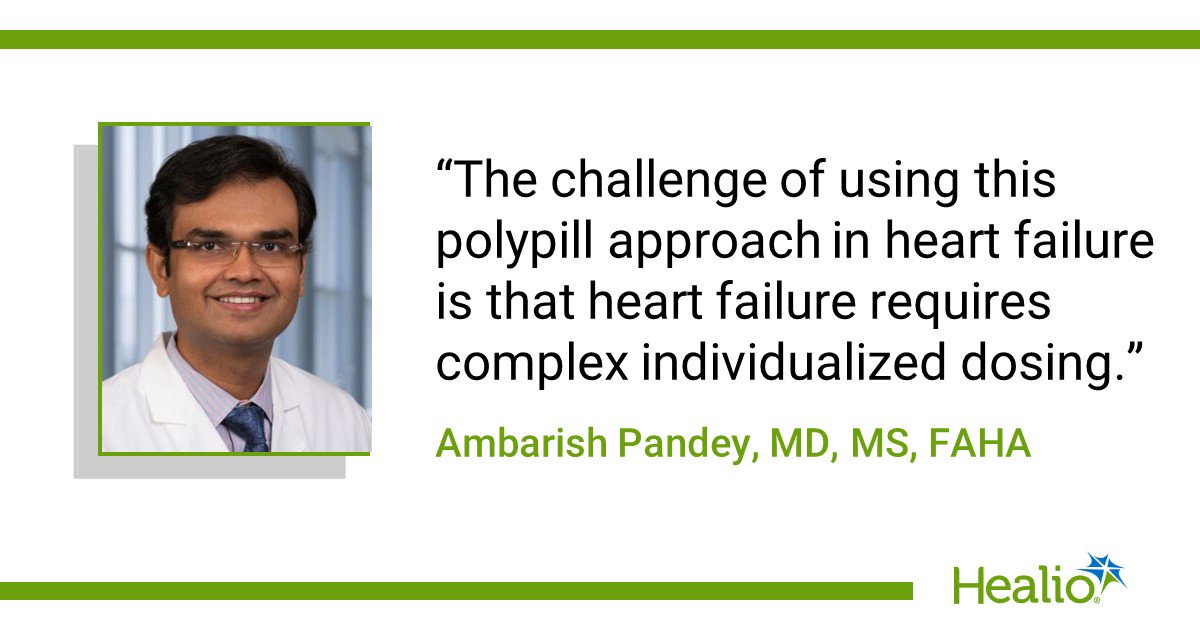November 10, 2025
3 min read
Key takeaways:
- A polypill strategy improved clinical outcomes and quality of life for people with heart failure with reduced ejection fraction.
- There was greater adherence among those who received a polypill vs. usual care.
NEW ORLEANS — A polypill containing three recommended heart failure therapies improved heart function, reduced hospitalizations and was associated with meaningful improvements in quality of life compared with usual care.
The burden of polypharmacy in HF is substantial and only 15% of people with HF with reduced ejection fraction receive the four guideline-directed medical therapies (GDMT) that can potentially halve mortality risk, Ambarish Pandey, MD, MS, FAHA, associate professor of internal medicine in the division of cardiology and geriatrics at UT Southwestern Medical Center in Dallas and medical director of the center’s heart failure with preserved ejection fraction program, said during a late-breaking science presentation at the American Heart Association Scientific Sessions.

“The solution we are testing in this study is a single pill that combines multiple medications already proven to be effective in preventing the adverse outcomes. … The challenge of using this polypill approach in heart failure is that heart failure requires complex individualized medication dosing and patients can have high risk of adverse outcomes. It is difficult to fit the management in a one-size-fits-all pill.”
Polypill vs. multiple pills
For the open-label POLY-HF trial, researchers enrolled 212 adults with HF with an EF of 40% or lower who were not receiving target-dose GDMT at two safety-net hospitals in Texas. The mean age of participants was 54 years, 22% were women, half identified as Black and 20% were Spanish-speaking. Most participants (70%) were uninsured or relying on county-sponsored programs; 43% reported experiencing food insecurity and 32% reported experiencing housing instability. The clinical HF burden was similarly high, with a median baseline left ventricular EF of 26% and 85% had a recent HF hospitalization.
Researchers randomly assigned participants to usual care with individualized GDMT (n = 104) or a once-daily over-encapsulated polypill with multiple dose formulations: metoprolol succinate 25/50/100/150 mg; spironolactone 12.5 mg; and the SGLT2 inhibitor empagliflozin 10 mg (Jardiance, Boehringer Ingelheim), along with a separate renin-angiotensin system inhibitor (n = 108).
The primary endpoint was change in LVEF from baseline to 6 months as assessed by cardiac MRI. Secondary endpoints included changes in N-terminal pro-B-type natriuretic peptide (NT-proBNP) level, quality of life measures and clinical outcomes.
At 6 months, researchers reported that LVEF improved by 3.4% more among people in the polypill group compared with usual care (39.9% vs. 36.5%; P = .024). The polypill strategy was also associated with improved clinical outcomes, including 60% fewer HF hospitalizations vs. usual care and an improvement in quality of life as assessed by the KCCQ (between-group difference, 8.5; 95% CI, 2.64-14.39; P = .005).
“We saw a robust improvement in the ejection fraction across both groups with a statistically significant greater improvement noted in the patients who received the polypill therapy vs. the usual care,” Pandey said during a press conference. “The heart function improvement was 3.4% more on follow-up with the polypill compared with usual care, and this difference was statistically significant.”
Pandey said participants in the polypill group were more likely to get prescribed and up-titrated on evidence-based therapies, a gradual increase Pandey said happened during follow-up,
“such that by the end of 6 months, 71% of the polypill arm participants were on optimal doses of all four classes of guideline-directed medical therapy as compared with 42% in the usual care arm.”
Polypill an ‘important piece to the implementation puzzle’
More research is needed on the implementation barriers and adherence to a polypill for HF, as well as a better understanding of adverse events that may necessitate discontinuation when a polypill is used on a larger scale, according to Orly Vardeny, PharmD, professor of medicine at the University of Minnesota.
“This was a racially and ethnically representative group that included a substantial proportion of patients with elements of socioeconomic vulnerability,” Vardeny said during a discussion of the findings. “These individuals are more likely to be nonadherent as well as more likely to have poor outcomes.”
Vardeny said 48% of participants were already prescribed quadruple GDMT at baseline; because of this, the POLY-HF trial focused less on GDMT initiation and more on adherence or sustaining of treatment.
“If a polypill were available, would people use it?” Vardeny asked. “A polypill does not address the potential baseline anxiety regarding simultaneous initiation of GDMT or hesitation with using specific components of GDMT — most notably, mineralocorticoid receptor antagonists. How do changes in renal function, blood pressure or electrolytes necessitate coming off the polypill when used long-term? And lastly, how do we anticipate cost or insurance coverage challenges with polypills moving forward?”
“The POLY-HF trial adds an important piece to the implementation puzzle,” Vardeny said. “In the end, it will take multiple parallel strategies to help ensure patients with HF get the necessary therapies that improve their quality of life and clinical outcomes.”











